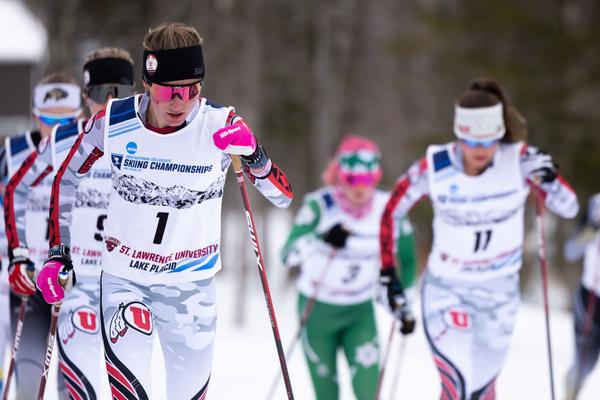NCAA skiing and the dominance of Utah on the college slopes

The GIST: Fresh powder’s still months away, but there’s no better time to, ahem, peak into NCAA skiing. It’s arguably the most unique college sport, combining divisions, genders, and race styles into one mountainous mashup. Let’s race.
The setup: Ski racing falls into two categories: Nordic, aka cross-country skiing, and Alpine, or downhill racing. There are 30 NCAA ski teams across three regional conferences: the Eastern Intercollegiate Ski Association (EISA), the Central Collegiate Ski Association (CCSA), and the Rocky Mountain Intercollegiate Ski Association (RMISA).
- EISA and RMISA schools compete in Nordic and Alpine disciplines, but because CCSA institutions aren’t in very mountainous geographic areas, those programs are Nordic or bust.
- In all conferences and competitions, all three divisions compete together. And while men and women race separately for individual glory and team points, skiing — along with fencing and rifle — is a rare coed NCAA sport.
How it works: Rosters can have as many skiers as a team wants (and can afford), with top schools often training around 12 each in Nordic and Alpine racing. All can compete in regular-season races, though only a pre-designated six per gender and per discipline can contribute to team scores. That number is sliced to just three at NCAA Championships.
- This means that coaches must try and predict which of their athletes will earn the best finishing places and snag the most points at competitions. Who knew helming an NCAA ski program required a crystal ball?
- Skiers often race in both of their discipline’s events. Alpine sprinting has the shorter but quick turn–heavy slalom and the longer but speedier grand slalom. Nordic endurance races come in women’s 5km or men’s 10km freestyle and 20km classical varieties.
The other org: Outside the NCAA, there are dozens of college ski teams nationwide (including at a slew of normally Division I [DI] institutions) that are governed by the United States Collegiate Ski Association (USCSA). The USCSA has its own conferences, competitions, and championships, but these teams can participate in NCAA races, too.
- Though it’s rare for USCSA skiers to qualify for NCAA Championships, it’s not impossible. In 2021, for example, Clarkson sent an entire Nordic contingent — men and women — to shoop, shoop against the NCAA’s best. Ice in their veins.
🎿 The Utah powerhouse with coach Miles Havlick
SOURCE: UTAHATHLETICS/TWITTER
The GIST: It’s hard to overstate how much Utah’s dominated college slopes lately. The Utes have won five of the last six national championships, including the last four straight titles, bringing the program’s team total to 16. Plus, they went undefeated in regular-season competition last year. Holy moly.
- Their main competitors are, unsurprisingly, Denver and Colorado, who lead all schools with 24 and 19 team titles, respectively, since the first was awarded in 1954. Vermont’s also gaining ground on these mountain powerhouses, but not as quickly as the Utes.
- Utah alum Miles Havlick won two individual Nordic nattys in 2012 and 2013. After a pro career and international coaching jobs, he returned to coach the Utes in 2018. Since then, Utah’s Nordic skiers have been nearly unstoppable.
The playbook: When asked about Utah’s success in our exclusive interview, Havlick cited the environment — the bonus of being minutes away from world-class slopes and Nordic areas — and the support from the university and the Salt Lake City community. The Utah license plate, he pointed out, even has a skier on it.
- Moreover, the team culture rises above the rest. “We’re super fortunate to be ski racers,” he said, “so it shouldn’t be taken too seriously. We should be serious about training and trying to improve, but having fun…is really the secret to success here.”
- “It’s a fine line between messing around and being too serious, so we’re constantly juggling that and trying to get people out of their comfort zone,” he continued. “[We have] a really unique group of people from all over the world…this diversity is really fun and different.”
The roster: On that note, international recruiting is clutch for college ski programs. Of Utah’s 28-person roster last season, 15 were listed as international students. There’s an especially strong contingent from Norway, which Havlick calls “the epicenter of cross-country skiing.”
- But Havlick said U.S. high schoolers “have been quite strong for the past four or five years,” especially in the last World Juniors competition. And this year’s NCAA women’s Nordic field was dominated by now–Utah alum Novie McCabe of Winthrop, WA.
The future: While some young talent skips college to go pro right away, Havlick says the NCAA is a crucial breeding ground for up-and-coming stars. “Our biggest challenge is just keeping skiers racing until they’re 28 or 30 years old when they reach their prime. So college skiing is an important four or five years that you can really train well and race.”
- “It’s pretty unique to any country in the world that we have NCAA skiing,” Havlick explained, “so if we can use it wisely, it’s a really important tool to our success on the world stage.” From NCAA to Team USA, one slope at a time.
Enjoying this article? Want more?

Sign up for The GIST and receive the latest sports news straight to your inbox three times a week.